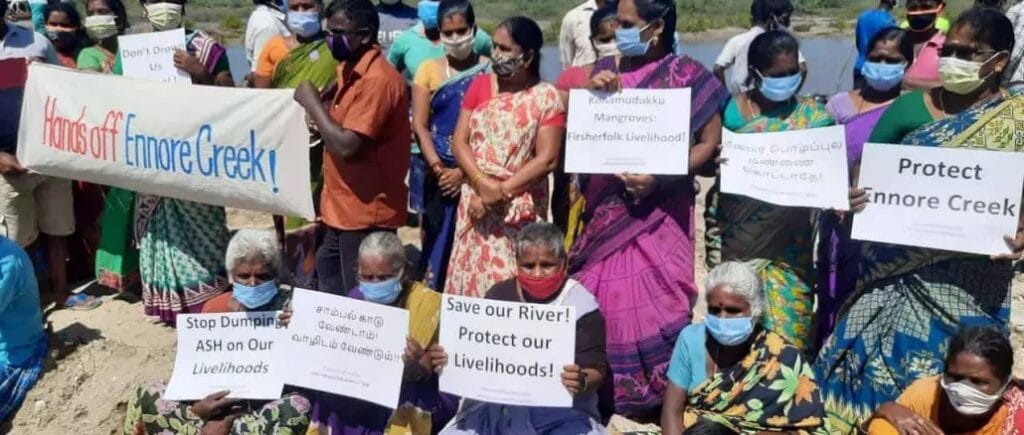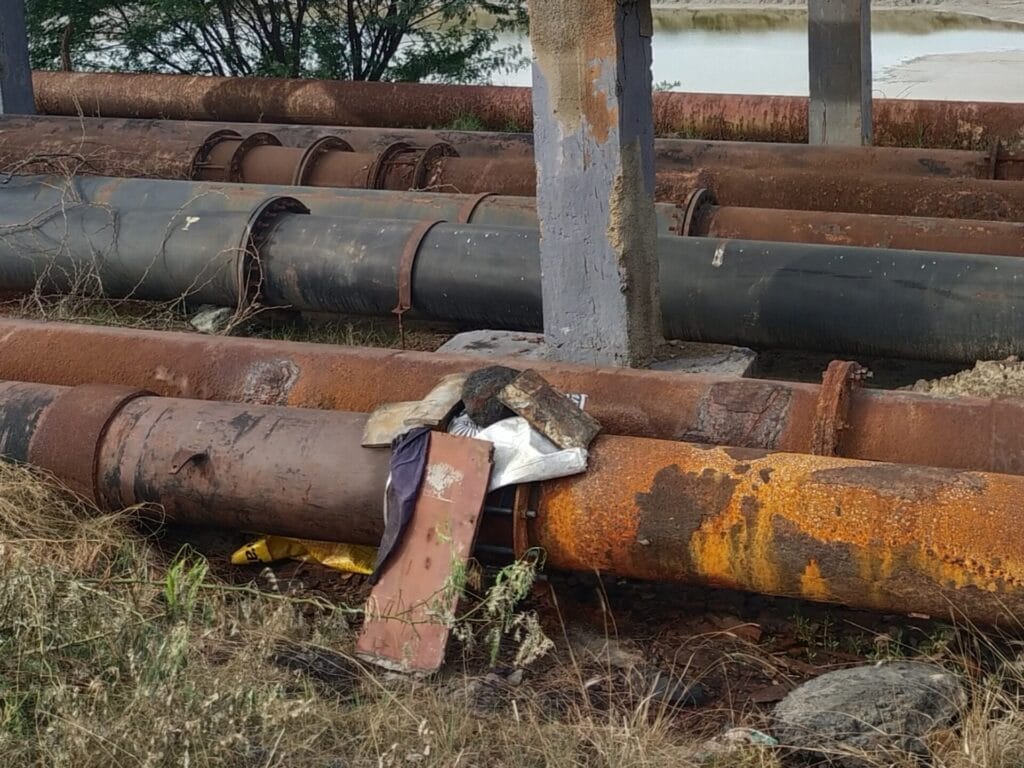‘Slow motion Bhopal’ — this was the title of the public hearing held recently to hear grievances of Ennore residents after the ammonia gas leak incident. As the title rightly points out, the episode was reminiscent of the horrors that people endured in the Bhopal gas tragedy. In the wee hours of December 27, residents in several areas around Ennore rushed out of their homes gasping for breath. Many complained of irritation in their eyes and throat, while some had blood oozing out of their nose. Few others, especially the elderly, fainted on the streets. All this happened after ammonia gas leaked from an underwater pipeline of Coromandel International Limited’s fertiliser factory.
Following the gas leak, 55 people were hospitalised and diagnosed with ammonia poisoning. Tamil Nadu Pollution Control Board (TNPCB) directed the factory to close for a week to fix the pipeline damage. A TNPCB report revealed that ammonia in the air was four times safe levels after 3 am on December 27 while ammonia in the sea was 10 times the marine discharge standards laid down by Central Pollution Control Board (CPCB). Contradicting this, Coromandel International said in a statement that the ammonia levels near the unloading pipeline were well below hazardous levels.
Since the incident, hundreds of residents have been protesting in front of the factory demanding its closure by the government. On January 1, Ennore Makkal Paadhukappu Kuzhu (a collective of representatives from 32 villages affected by environmental pollution in Ennore) organised a public hearing by a panel headed by Justice (Retd) K Kannan. During the hearing, residents narrated their ordeal of living amidst polluting industries and the long-term health impacts they have suffered as a consequence. The panel recommended an immediate health survey in the area.
Meanwhile, taking suo-moto cognisance of the ammonia gas leak incident, the southern bench of the National Green Tribunal heard the case on January 2 and assured action against those responsible for the leak. Adjourning the hearing to January 8, the NGT ordered Coromandel International, the Fisheries department and the Directorate of Industrial Safety and Health to submit a report.
Not less than a week before the gas leak incident, Ennore was in the news for an oil spill. A few days before that, it was devastated by floods. For residents of the villages here, ecological degradation and industrial pollution are monsters they are forced to live with. “These incidents are seen as triggers while the underlying structural issues have to be addressed,” said Kalpana Karunakaran, IIT-M professor of humanities, who was one of the panellists at the public hearing.
Over the years Citizen Matters has covered in depth, the environmental, economical and social issues faced by Ennore residents. Here are some of those important stories that stay relevant to the recent developments.
Read more: Oil spill in Ennore brings fishing to a standstill
Impact of industrial pollution on health, livelihood and environment
The story of Ennore is neither new nor untold. However, there is a constant need to retell it, because justice seems to be elusive. Both public and private sector industries have been exploiting the natural resources of Ennore since 1993. Who suffers the consequences? The residents in eight villages of Ennore, for whom clean air and potable water have become an unattainable luxury. This article titled, ‘How industrialisation has rung the death knell for Ennore’s ecology records the daily ordeals of people affected by industrial pollution.
The article ‘Women of Ennore are living testimony to the many costs of pollution‘ connects the impact of industrial pollution on health to the economic insecurity faced by families living in and around Ennore, and the subsequent toll on the mental health of women in these families. It also touches upon how the sludge-filled Kosasthalaiyar has become a death trap for the fishermen venturing out into the waters. Adding to the existing issues, Tamil Nadu Transmission Corporation (TANTRANSCO) decided to install a power transmission tower inside the Ennore Creek backwaters area of the Kosasthalaiyar river. Despite protests by fisherfolk, the construction went on. A few days after the protest, 31-year-old Vignesh, a fisherman from Mugatwarakuppam was killed after his boat hit the construction debris dumped inside the river for illegal construction of power transmission towers.

The article titled ‘Ennore backwaters an “environmental crime scene” as fly ash dumping and encroachment continue‘ delves deep into the impact of fly ash pollution that poses a grave threat to the environment and ecology in the region. At the behest of local fishermen, a three-member team of Professor S Janakarajan, President of the South Asia Consortium for Interdisciplinary Water Resources Studies; G Sundarrajan of Poovulagin Nanbargal and musician T M Krishna assessed violations at the Ennore creek. Observing that the Ennore backwaters resemble an environmental crime scene while the TNPCB is missing in action, the inspection team noted that despite many orders by the Madras High Court and the southern bench of the National Green Tribunal to clear out the fly ash from the waters of Ennore, nothing has been done to undo the harm.

Interestingly, during a ‘toxic tour’, we found how a leakage in the ash pipes was plugged with a mere sack covering the pipe and a stone placed on top to hold it in place. Despite so much of technological developments, this showed the lack of willingness from the government to take serious measures. The toxic tour also helped us understand that pollution in North Chennai is not merely a ‘North Chennai’ problem but the problem of the whole of Chennai.
How has TNPCB failed North Chennai?
There is enough data that proves the violation by industries. Above all, people living in and around Ennore are living testimony to the impact of industrial pollution in the region. However, the TNPCB, which has the authority to monitor industries has failed to play its part. The article ‘How has TNPCB failed North Chennai?‘ talks of the lack of initiative shown by TNPCB to regulate polluters.
“The TNPCB is not aiming to shut down industries. We give them an opportunity to course-correct through notices, hearings and action plans. Only as a last resort, we issue orders to shut down the plants,” said an official. The official also pointed out that both the TNPCB and the industries under the scanner in North Chennai are part of the same government machinery. This makes ensuring compliance difficult.
Whenever people in these villages raise their voice, the government machinery asks one question — “Do you not want electricity or any form of development in our state/country?” Kalpana points out that the government would have not been able to set up these industries in areas like RA Puram or Adyar in South Chennai given the resistance put up by residents. Since the people in North Chennai, who are bearing the brunt of the industrial pollution are working-class people, these industries have cropped up here. “Shouldn’t development be for all? Why should we and our children bear the brunt for the development of others,” ask the residents of Ennore.